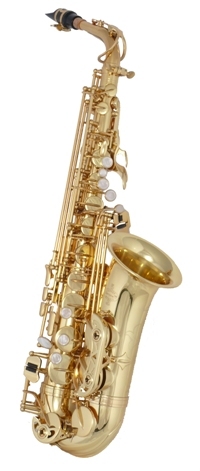Th e first thing you’ll need to do is familiarize yourself with brands and models. There are many different brands and models of saxophones and it can be a daunting task to wade through the sea of instruments available to the prospective buyer. There’s endless amounts of information online but for many this can add to the confusion. Enlisting the help of school teachers/private lesson teachers, local professionals and music store employees will help narrow down the search. Once you’ve decided on a specific make/model or two you can then use the internet more effectively by reading reviews and gathering what you can from the manufacturer’s website to act as your own saxophone buyer’s guide.
e first thing you’ll need to do is familiarize yourself with brands and models. There are many different brands and models of saxophones and it can be a daunting task to wade through the sea of instruments available to the prospective buyer. There’s endless amounts of information online but for many this can add to the confusion. Enlisting the help of school teachers/private lesson teachers, local professionals and music store employees will help narrow down the search. Once you’ve decided on a specific make/model or two you can then use the internet more effectively by reading reviews and gathering what you can from the manufacturer’s website to act as your own saxophone buyer’s guide.
You don't have to buy the most expensive instrument but you should always try to get the best instrument you can afford. Nicer instruments with a reputable brand name tend to hold their value much better than the smaller off-brand variety. Another factor may be the type of playing one chooses to do, you wouldn't want to bring your expensive professional model saxophone to marching band practice where it could be easily damaged. If you're just beginning your musical journey it's best to go with a good student model horn for this very reason.
Used or New? It's true that used instruments can be cheaper and in certain cases every bit as good as a new instrument. If you go the used route make sure you have someone that can help you choose a decent used instrument in good condition that plays well. Be very careful when buying instruments through places like Ebay and never purchase an instrument you can't try before you buy. Used instruments do not come with warranties so you will be responsible for any and all repairs that may be necessary turning a bargain into a nightmare.
Brand Name vs. Off Brand
It's best to go with a known brand name if purchasing for the first time. Brands such as Conn-Selmer, Keilwerth and Yanigisawa have strong reputations and offer better warranties than most competitors. These companies offer a wide range of instruments and prices to choose from. Cheaper instruments from lesser known brands will be easy to obtain but may end up costing you more in the end with frequent trips to the repair shop and the potential added headache of hard to get replacement parts. Of course, purchasing an off brand instrument doesn't always spell disaster but these are things one should consider before purchasing. I've listed a few saxophone testing tips below that may be helpful in your search for a new saxophone.
Saxophone Testing Tips for Beginners
If you've never played an instrument before you'll need to rely on the expertise of your local music store. I would avoid buying used through places like Craigslist or Ebay unless you know someone who can help you evaluate the overall condition and quality of the instrument. It's best to go with a good student model saxophone since most young students will have an accident or two in the early years of development. I recommend going with student line of saxophones from Selmer or Yamaha, they're going to give you're child the best chance to succeed.
One of the most overlooked aspects of playing the saxophone in the early stages is the mouthpiece, reed and ligature combination. This is where everything begins, the reed, held in place by the ligature vibrates against the mouthpiece producing sound. Many instruments come with poor quality mouthpieces making it difficult to produce a good sound . Spending a little extra time and money in this area can make this process much more enjoyable so don't skimp here. Vandoren makes many great mouthpieces that are reasonably priced and a good place to start would be with the models AL3 and AL4. Selmer makes a mouthpiece called the S-80 C*(star), this is one of the most widely played mouthpieces and almost all saxophonists play one of these at one point or another.
Head to our online store to check out our new and used saxophones.
Saxophone Testing Tips for Players Looking to Upgrade
- Bring your current saxophone, mouthpiece, reeds, ligature and a tuner whenever you try a new or used instrument. This way you can compare the instruments your testing with your current saxophone and get a better sense of differences between them.
- Try to play the full range of the saxophone starting on the lowest note of the instrument chromatically up to the highest note you can play and back down again. It might be helpful to bring a notebook with you so you can write down any notes that seem stuffy or different from the rest to help isolate problem areas.
- If possible, ask your private teacher to join you. This is really the best and most efficient way to handle this process.
- Make sure to take a close look at the instrument as you put it together noting any problems you find such as loose corks, bent or sticking keys/pads, loose screws or springs etc. These issues will be more prevalent with used instruments.
